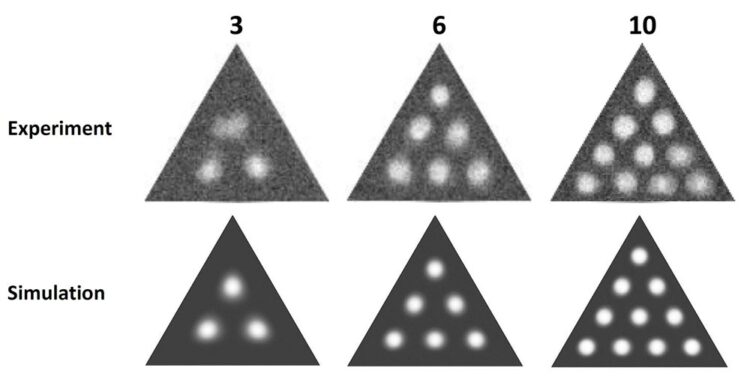Magnetic whirls in confined spaces

Stable states with three, six, and ten skyrmions enclosed in a triangle. The plot shows time-averaged skyrmion positions from experiment (top row) and corresponding computer simulations (bottom row).
Ill./©: Jan Rothörl, Chengkun Song
Mobility of skyrmions in geometric structures depends on their arrangement.
In a close collaboration between experimental and theoretical physicists at Johannes Gutenberg University Mainz (JGU), the research groups of Professor Mathias Kläui and Dr. Peter Virnau investigated the behavior of magnetic whirls within nanoscale geometric structures.
In their work published in “Advanced Functional Materials”, the researchers confined small magnetic whirls, so-called skyrmions, in geometric structures. Skyrmions can be created in thin metal films and have particle-like properties: They exhibit high stability and are repelled from each other and from specially prepared walls.
Experiments and accompanying computer simulations showed that the mobility of skyrmions within these geometric structures depends massively on their arrangement. In triangles, for example, three, six, or ten skyrmions arranged like bowling pins are particularly stable.
“These studies lay the foundation for the development of novel non-conventional computing and storage media based on the movement of magnetic vortices through microscopic corridors and chambers,” explained Professor Mathias Kläui. The research was funded by the Dynamics and Topology (TopDyn) Top-level Research Area, which was founded in 2019 as a collaboration between Johannes Gutenberg University Mainz, TU Kaiserslautern, and the Max Planck Institute for Polymer Research in Mainz.
“This work is an excellent example for the interdisciplinary cooperation between simulation and experiment, which was only made possible by TopDyn’s funding,” emphasized Dr. Peter Virnau.
Wissenschaftliche Ansprechpartner:
PD Dr. Peter Virnau
Statistical Physics and Soft Matter Theory group
Institute of Physics
Johannes Gutenberg University Mainz
55099 Mainz, GERMANY
phone +49 6131 39-20493
fax +49 6131 39-20496
e-mail: virnau@uni-mainz.de
https://www.komet1.physik.uni-mainz.de/people/peter-virnau/
Professor Dr. Mathias Kläui
Condensed Matter Theory group
Institute of Physics
Johannes Gutenberg University Mainz
55099 Mainz, GERMANY
phone +49 6131 39-23633
e-mail: klaeui@uni-mainz.de
https://www.klaeui-lab.physik.uni-mainz.de/homepage-prof-dr-mathias-klaeui/
Originalpublikation:
C. Song et al., Commensurability between Element Symmetry and the Number of Skyrmions Governing Skyrmion Diffusion in Confined Geometries, Advanced Functional Materials, 28 February 2021,
DOI: 10.1002/adfm.202010739
https://onlinelibrary.wiley.com/doi/10.1002/adfm.202010739
Weitere Informationen:
Related links:
https://www.klaeui-lab.physik.uni-mainz.de – Kläui Lab at the JGU Institute of Physics ;
https://www.komet1.physik.uni-mainz.de/ – Statistical Physics and Soft Matter Theory group at the JGU Institute of Physics ;
https://topdyn.uni-mainz.de/ – Dynamics and Topology (TopDyn) Top-level Research Area
Read more:
https://www.uni-mainz.de/presse/aktuell/12071_ENG_HTML.php – press release “Magnetic whirls crystallize in two dimensions” (9 Sept. 2020)
Media Contact
All latest news from the category: Physics and Astronomy
This area deals with the fundamental laws and building blocks of nature and how they interact, the properties and the behavior of matter, and research into space and time and their structures.
innovations-report provides in-depth reports and articles on subjects such as astrophysics, laser technologies, nuclear, quantum, particle and solid-state physics, nanotechnologies, planetary research and findings (Mars, Venus) and developments related to the Hubble Telescope.
Newest articles

Bringing bio-inspired robots to life
Nebraska researcher Eric Markvicka gets NSF CAREER Award to pursue manufacture of novel materials for soft robotics and stretchable electronics. Engineers are increasingly eager to develop robots that mimic the…

Bella moths use poison to attract mates
Scientists are closer to finding out how. Pyrrolizidine alkaloids are as bitter and toxic as they are hard to pronounce. They’re produced by several different types of plants and are…

AI tool creates ‘synthetic’ images of cells
…for enhanced microscopy analysis. Observing individual cells through microscopes can reveal a range of important cell biological phenomena that frequently play a role in human diseases, but the process of…





















